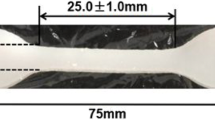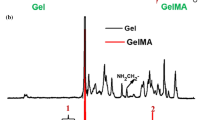Abstract
A polyacrylic acid (PAA)/gelatin (Gela)/polyvinyl alcohol (PVA) hydrogel was prepared by copolymerization, cooling, and freezing/thawing methods. This triple-network (TN) structure hydrogel displayed superior mechanical properties, low swelling ratio and self-healing properties. The superior mechanical properties are attributed to the triple helix association of Gela and PVA crystallites by reversible hydrogen bonding. The characterization results indicated that the fracture stress and the strain were 808 kPa and 370% respectively, while the compression strength could reach 4443 kPa and the compressive modulus was up to 39 MPa under the deformation of 90%. The hydrogen bonding in PVA contributed to maintain and improve the self-healing ability of hydrogels. Every type of hydrogels exhibited a higher swelling ratio under alkaline conditions, and the swelling ratios of PAA, PAA/PVA and PAA/Gela hydrogels were 27.71, 12.30 and 9.09, respectively. The PAA/Gela/PVA TN hydrogel showed the lowest swelling ratio (6.57) among these hydrogels. These results indicate that the novel TN hydrogels possess good environmental adaptability and have potential applications in the biomedical engineering and sensor field.
Similar content being viewed by others
References
Liu X, Duan L, Gao G. Rapidly self-recoverable and fatigue-resistant hydrogels toughened by chemical crosslinking and hydrophobic association. European Polymer Journal, 2017, 89: 185–194
Tavsanli B, Can V, Okay O. Mechanically strong triple network hydrogels based on hyaluronan and poly(N,N-dimethylacrylamide). Soft Matter, 2015, 11(43): 8517–8524
Frederix P W, Kania R, Wright J A, et al. Encapsulating [FeFe]-hydrogenase model compounds in peptide hydrogels dramatically modifies stability and photochemistry. Dalton Transactions, 2012, 41(42): 13112–13119
Yin H, Akasaki T, Sun T L, et al. Double network hydrogels from polyzwitterions: high mechanical strength and excellent antibiofouling properties. Journal of Materials Chemistry B: Materials for Biology and Medicine, 2013, 1(30): 3685–3693
Fan C, Liao L, Zhang C, et al. A tough double network hydrogel for cartilage tissue engineering. Journal of Materials Chemistry B: Materials for Biology and Medicine, 2013, 1(34): 4251–4258
Xu R, Zhou G, Tang Y, et al. New double network hydrogel adsorbent: Highly efficient removal of Cd(II) and Mn(II) ions in aqueous solution. Chemical Engineering Journal, 2015, 275: 179–188
Hu Y, Du Z, Deng X, et al. Dual physically cross-linked hydrogels with high stretchability, toughness, and good self-recoverability. Macromolecules, 2016, 49(15): 5660–5668
Kamata H, Akagi Y, Kayasuga-Kariya Y, et al. “Nonswellable” hydrogel without mechanical hysteresis. Science, 2014, 343 (6173): 873–875
Zhuang Y, Yu F, Chen H, et al. Alginate/graphene double-network nanocomposite hydrogel bead with low-swelling, enhanced mechanical property, and enhanced adsorption capacity. Journal of Materials Chemistry A: Materials for Energy and Sustainability, 2016, 4(28): 10885–10892
Yu P, Bao R Y, Shi X J, et al. Self-assembled high-strength hydroxyapatite/graphene oxide/chitosan composite hydrogel for bone tissue engineering. Carbohydrate Polymers, 2017, 155: 507–515
Shao C, Chang H, Wang M, et al. High-strength, tough, and selfhealing nanocomposite physical hydrogels based on the synergistic effects of dynamic hydrogen bond and dual coordination bonds. ACS Applied Materials & Interfaces, 2017, 9(34): 28305–28318
Xin H, Saricilar S Z, Brown H R, et al. Effect of first network topology on the toughness of double network hydrogels. Macromolecules, 2013, 46(16): 6613–6620
Li H, Hao D, Fan J, et al. A robust double-network hydrogel with under sea water superoleophobicity fabricated via one-pot, onestep reaction. Journal of Materials Chemistry B: Materials for Biology and Medicine, 2016, 4(27): 4662–4666
Wang Y, Yan J, Wang Z, et al. One-pot fabrication of triplenetwork structure hydrogels with high-strength and self-healing properties. Materials Letters, 2017, 207: 53–56
Jiang X, Xiang N, Wang J, et al. Preparation and characterization of hybrid double network chitosan/poly(acrylic amide-acrylic acid) high toughness hydrogel through Al3+ crosslinking. Carbohydrate Polymers, 2017, 173: 701–706
Chen Q, Chen H, Zhu L, et al. Fundamentals of double network hydrogels. Journal of Materials Chemistry B: Materials for Biology and Medicine, 2015, 3(18): 3654–3676
Singh N, Maity C, Zhang K, et al. Synthesis of a double network supramolecular hydrogel by having one network catalyse the formation of the second. Chemistry -A European Journal, 2017, 23(9): 2018–2021
Gong J P, Katsuyama Y, Kurokawa T, et al. Double-network hydrogels with extremely high mechanical strength. Advanced Materials, 2003, 15(14): 1155–1158
Chen H, Chen Q, Hu R, et al. Mechanically strong hybrid double network hydrogels with antifouling property. Journal of Materials Chemistry B: Materials for Biology and Medicine, 2015, 3(27): 5426–5435
Zhu P, Hu M, Deng Y, et al. One-pot fabrication of a novel agarpolyacrylamide/graphene oxide nanocomposite double network hydrogel with high mechanical properties. Advanced Engineering Materials, 2016, 18(10): 1799–1807
Nakayama A, Kakugo A, Gong J P, et al. High mechanical strength double-network hydrogel with bacterial cellulose. Advanced Functional Materials, 2004, 14(11): 1124–1128
Weng L, Gouldstone A, Wu Y, et al. Mechanically strong double network photocrosslinked hydrogels from N, N-dimethylacrylamide and glycidyl methacrylated hyaluronan. Biomaterials, 2008, 29(14): 2153–2163
Waters D J, Engberg K, Parke-Houben R, et al. Structure and mechanism of strength enhancement in interpenetrating polymer network hydrogels. Macromolecules, 2011, 44(14): 5776–5787
Gulyuz U, Okay O. Self-healing polyacrylic acid hydrogels. Soft Matter, 2013, 9(43): 10287–10293
Wang Y, Niu J, Hou J, et al. A novel design strategy for triplenetwork structure hydrogels with high-strength, tough and selfhealing properties. Polymer, 2018, 135: 16–24
Jia H, Huang Z, Fei Z, et al. Unconventional tough doublenetwork hydrogels with rapid mechanical recovery, self-healing, and self-gluing properties. ACS Applied Materials & Interfaces, 2016, 8(45): 31339–31347
Wang X, Deng W, Xie Y, et al. Selective removal of mercury ions using a chitosan–poly(vinyl alcohol) hydrogel adsorbent with three-dimensional network structure. Chemical Engineering Journal, 2013, 228: 232–242
Wang Y, Wang Z, Wu K, et al. Synthesis of cellulose-based double-network hydrogels demonstrating high strength, selfhealing, and antibacterial properties. Carbohydrate Polymers, 2017, 168: 112–120
Tang Q, Sun X, Li Q, et al. A simple route to interpenetrating network hydrogel with high mechanical strength. Journal of Colloid and Interface Science, 2009, 339(1): 45–52
Sun W, Xue B, Li Y, et al. Polymer-supramolecular polymer double-network hydrogel. Advanced Functional Materials, 2016, 26(48): 9044–9052
Wang Y, Zhang C, Zhao L, et al. Cellulose-based porous adsorbents with high capacity for methylene blue adsorption from aqueous solutions. Fibers and Polymers, 2017, 18(5): 891–899
Sabzi M, Samadi N, Abbasi F, et al. Bioinspired fully physically cross-linked double network hydrogels with a robust, tough and self-healing structure. Materials Science and Engineering C, 2017, 74: 374–381
Alavijeh R Z, Shokrollahi P, Barzin J. A thermally and water activated shape memory gelatin physical hydrogel, with a gel point above the physiological temperature, for biomedical applications. Journal of Materials Chemistry B: Materials for Biology and Medicine, 2017, 5(12): 2302–2314
Gornall J L, Terentjev E M. Helix–coil transition of gelatin: helical morphology and stability. Soft Matter, 2008, 4(3): 544–549
Cui L, Jia J, Guo Y, et al. Preparation and characterization of IPN hydrogels composed of chitosan and gelatin cross-linked by genipin. Carbohydrate Polymers, 2014, 99: 31–38
Li X, Yang Q, Zhao Y, et al. Dual physically crosslinked double network hydrogels with high toughness and self-healing properties. Soft Matter, 2017, 13(5): 911–920
Gong J P. Why are double network hydrogels so tough? Soft Matter, 2010, 6(12): 2583–2590
Zhao X. Multi-scale multi-mechanism design of tough hydrogels: building dissipation into stretchy networks. Soft Matter, 2014, 10 (5): 672–687
Miyazaki T, Hoshiko A, Akasaka M, et al. SAXS studies on structural changes in a poly(vinyl alcohol) film during uniaxial stretching in water. Macromolecules, 2006, 39(8): 2921–2929
Li J, Suo Z, Vlassak J J. Stiff, strong, and tough hydrogels with good chemical stability. Journal of Materials Chemistry B: Materials for Biology and Medicine, 2014, 2(39): 6708–6713
Na Y, Tanaka Y, Kawauchi Y, et al. Necking phenomenon of double-network gels. Macromolecules, 2006, 39(14): 4641–4645
Acknowledgements
This work was supported financially by funding from the National Natural Science Foundation of China (Grant Nos. 51662036 and 21467024) and the Graduate Student Scientific Research Innovation Projects in Xinjiang Autonomous Region, China (XJGRI2017046).
Author information
Authors and Affiliations
Corresponding authors
Rights and permissions
About this article
Cite this article
Wang, Z., Han, X., Wang, Y. et al. Facile preparation of low swelling, high strength, self-healing and pH-responsive hydrogels based on the triple-network structure. Front. Mater. Sci. 13, 54–63 (2019). https://doi.org/10.1007/s11706-019-0450-7
Received:
Accepted:
Published:
Issue Date:
DOI: https://doi.org/10.1007/s11706-019-0450-7




